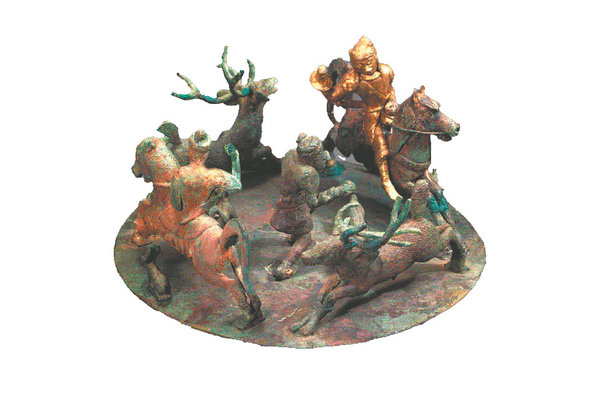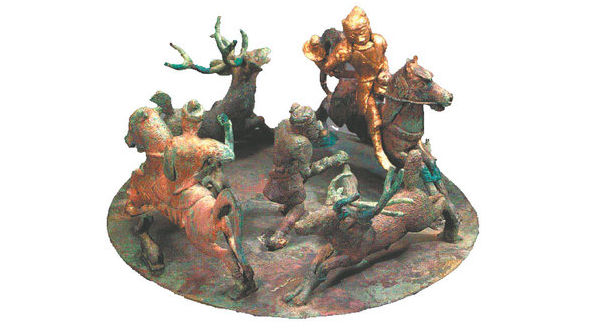
A bronze cowrie container with a lid (pictured) depicts the hunting scene of the Dian people who lived along the shores of Dianchi Lake in Kunming of Yunnan province over 2,000 years ago. [Photo provided to China Daily]
The bronze lids of the cowrie containers, for instance, were adorned with tiny figures and structures, showcasing scenes from the daily lives of the Dian people, such as hunting, farming, and weaving. They also captured the Dian people's leisure activities, including bullfighting, dancing and making music.
In the collection of the Yunnan Provincial Museum lies a fascinating bronze cowrie container from the Western Han Dynasty (206 BC-AD 24), crafted by skillfully welding two bronze drums together. Its lid vividly captures a hunting scene: three figures, each armed with a long sword. Two of them are mounted on horseback, in hot pursuit of a fleeing deer, with one rider entirely gilded. The third figure stands at the center of the lid, poised to hunt another deer, flanked by two dogs ready to pounce on their prey.
The bronze lid resembles a miniature society, intricately carved with a multitude of human and animal figures. The most populated of these cowrie containers, now housed in the National Museum of China in Beijing, boasts an impressive 32-centimeter diameter lid adorned with 129 figures. It also features stilted buildings, bronze drums, columns, cauldrons and various animals, making it the most complex piece among the bronze artifacts of the Dian Kingdom.
This elaborate creation captures a widely practiced sacrificial ritual among the ancient southwestern tribes. The sacrificial plaza depicted on the bronze lid also doubles as a bustling marketplace, reflecting the vibrant trade exchanges that the Dian Kingdom maintained with neighboring states and regions.
Animals are a focal point in the intricate carvings of Dian bronze ware, such as oxen, tigers, deer, monkeys, rabbits and birds. These creatures are depicted either alone, in groups, or interacting with humans, all rendered in unique and lifelike forms. Among these, oxen are the most frequently represented.
During the agrarian civilization era, the people of Dian did not use oxen for farming, says Fan. Over 2,000 years ago, they held oxen in high reverence, using them solely for sacrificial offerings. The Dian people were also among the earliest in the world to engage in bullfighting and related activities. A bronze buckle ornament collected by Fan's museum vividly depicts a scene of an intense bullfighting event.
Due to the scarce historical written records about the ancient Dian Kingdom, there have been doubts about whether this regional state inhabited by indigenous people truly existed, says Jiang Zhilong, a researcher at the Yunnan Provincial Institute of Cultural Relics and Archaeology.
In 1956, the unearthing of a large number of bronze artifacts, including these uniquely-shaped cowrie containers, unveiled the mysteries of this ancient kingdom that had been dormant for over 2,000 years. Recently, discoveries of Jiang's team of a significant amount of clay seals and wooden slips at the Hebosuo site in Kunming have further provided textual evidence confirming the existence and demise of the ancient Dian Kingdom.
"We still need to spend years conducting further research on the ancient Dian Kingdom," says Jiang.


 Share:
Share: 




 京公網安備 11010802027341號
京公網安備 11010802027341號 主站蜘蛛池模板:
河池市|
临海市|
乐至县|
界首市|
登封市|
太保市|
泾源县|
安吉县|
从江县|
漳浦县|
汝阳县|
贵阳市|
贵定县|
博客|
肥城市|
德庆县|
福州市|
舞阳县|
冀州市|
红原县|
大渡口区|
新干县|
汶上县|
西乌珠穆沁旗|
东兴市|
兴义市|
滕州市|
晋江市|
汉阴县|
德钦县|
漯河市|
旬阳县|
五大连池市|
星子县|
清原|
云南省|
台东县|
天镇县|
崇阳县|
夏河县|
新昌县|
主站蜘蛛池模板:
河池市|
临海市|
乐至县|
界首市|
登封市|
太保市|
泾源县|
安吉县|
从江县|
漳浦县|
汝阳县|
贵阳市|
贵定县|
博客|
肥城市|
德庆县|
福州市|
舞阳县|
冀州市|
红原县|
大渡口区|
新干县|
汶上县|
西乌珠穆沁旗|
东兴市|
兴义市|
滕州市|
晋江市|
汉阴县|
德钦县|
漯河市|
旬阳县|
五大连池市|
星子县|
清原|
云南省|
台东县|
天镇县|
崇阳县|
夏河县|
新昌县|